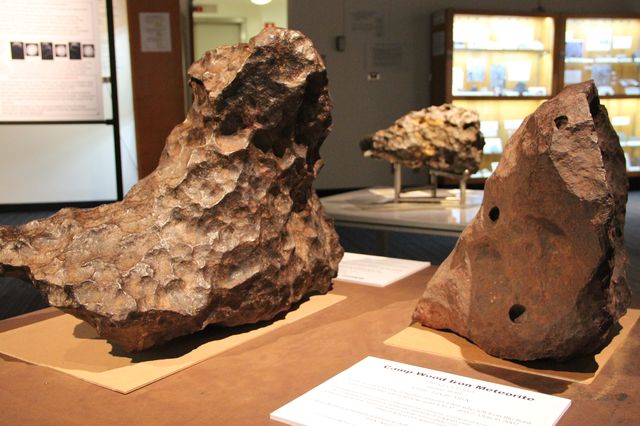 UCLA’s Meteorite Gallery has added two large iron meteorites, one weighing more than 800 pounds.
UCLA’s Meteorite Gallery has added two large iron meteorites, one weighing more than 800 pounds.Credit: Christelle Nahas
April 2, 2015 - By Stuart Wolpert - The UCLA Meteorite Gallery, California’s largest collection of meteorites, has added two large iron meteorites — and both may be touched by the public. Admission to the gallery is free.
One of the new meteorites is now the largest in Los Angeles. Weighing 811 pounds, it is more than twice the size of what had been the gallery’s largest meteorite. It was found in Namibia, and is being displayed thanks to a long-term loan by UCLA alumnus Peter Utas and his wife, Barbara Broide.
John Wasson, the gallery’s curator and a professor of geochemistry and chemistry in the UCLA College, described the specimen as “beautiful, with parallel sets of fine bands crossing it.”
The other meteorite, also on loan from the Utas family, weighs 326 pounds and was found in Texas. It was first recognized by a hunter in the late 1960s, and it remained on the hunter’s front porch until his son’s widow sold it to the Utas family in 2007.
The Meteorite Gallery is open from 9 a.m. until 4 p.m., Monday through Friday, except on holidays, and from 1 to 4 p.m. on Sundays, when a docent is available to answer questions. The gallery is room 3697 of the UCLA Geology Building, which is located just southwest of the corner of Hilgard and Westholme avenues (map).
Meteorites are rocks ejected from asteroids, planets or the moon and have landed on the Earth’s surface. The vast majority come from asteroids. Those made principally of iron are fairly rare and easy to identify, Wasson said.
Among the gallery’s other holdings is a 357-pound chunk of the Canyon Diablo iron meteorite, part of a large asteroid that crashed into the Arizona desert some 50,000 years ago, creating a mile-wide crater just east of present-day Flagstaff. In all, the collection houses nearly 1,500 meteorites that illustrate the scientific processes that were active in the early solar system. About 100 of them are on display.
The gallery, which opened last year, offers information about a wide variety of topics related to meteorites. Exhibits explain how to identify meteorites and the processes that brought meteorites from the asteroid belt to the Earth, among other information. The Meteorite Gallery is supported by the UCLA College, UCLA’s department of earth, planetary and space sciences and the Institute for Planets and Exoplanets.








